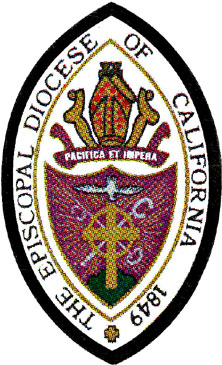Please see discussion on the talk page.

Seal of the Diocese of California
One of six Anglican dioceses in California. It covers the counties of San Francisco, San Mateo, Marin, Alameda, and Contra Costa. The Diocese has eighty-eight congregations. Its current bishop is the Right Reverend William Edwin Swing. Bishop Swing has announced his retirement late in 2006 and has called for the election of his successor in May 2006.
History[]
The first Anglican liturgy offered in North America was offered by the Rev. Francis Fletcher, chaplain of Sir Francis Drake's ship the Golden Hinde. The ship pulled ashore for repairs in Northern California, most likely in what is now Drake's Bay on Point Reyes, on June 17, 1579. Fr. Fletcher is likely to have offered the daily offices, and on the Feast of St. John the Baptist, June 24, his diary records that he offered Holy Communion, at which a group of curious natives observed. The Golden Hinde left Drake's Bay on July 23.
The Diocese of California was organized in 1850 and formally recognized by the Episcopal Church in 1857, under the jurisdiction of its first bishop, William Ingraham Kip.
In 1874, the diocese was divided and the Diocese of Sacramento was formed (now the Diocese of Northern California). In 1895 the Diocese of Los Angeles was formed from the southern portion of the state.
The diocese was instrumental in the foundation of the Church Divinity School of the Pacific in 1893, providing seminary training for clergy candidates of the West.
In 1906, San Francisco was struck by a calamitous earthquake and fire, which destroyed the diocesan house and half of the city's parishes, as well as St. Luke's Hospital. The diocese was an active partner in relief efforts. The church rebuilt quickly along with the rest of San Francisco. The following year's diocesan convention in 1907 committed the diocese to an activist platform, creating a structure for diocesan institutions to address societal problems of graft, vice, disease, corruption, and other social issues.
In 1908, the diocese was again divided, with the creation of the Missionary District of San Joaquin Valley (now the Diocese of San Joaquin).
Construction of Grace Cathedral began in 1910, with the laying of the cornerstone by Bishop William Ford Nichols. The crypt was complete in 1914 and served as the cathedral for the next eighteen years. Construction was suspended during World War I, but under Bishop Edward Lambe Parsons, contruction was renewed in 1929. By 1931 the Chapel of Grace was complete and served as the cathedral. Due to the Great Depression, labor was cheap, and by 1934, the apse, choir, transept, and half of the nave were complete. At the outbreak of World War II, construction stopped again, and the nave was closed off with a steel wall. The last major stretch of construction was carred out 1961-64 under Bishop James Albert Pike.
Bishop Pike was a controversial figure. His theology was in some ways unconventional and he ordained Deaconess Phyllis Edwards to the diaconate in 1965, creating tremendous controversy. Calls were made in the House of Bishops to present and try Pike for heresy. After the death of his son James, Jr. in 1966, Pike resigned in May of that year. After further accusations of heresy, the House of Bishops decided not to pursue the case further. Pike retired to a career of lecturing and study which was cut short by his death in the Judean wilderness in September of 1969.
During the late 1960s and early 1970s the Diocese was a place of traditional worship as well as experimentation, with institutions such as Berkeley's "Free Church" which ministered to hippies, with Saturday evening services with "rap sessions" in place of sermons, and rock music.
The tenure of Bishop William Swing has been marked by an expansion and revitalization of social programs and institutions inthe diocese, and the organization of Episcopal Charities, an umbrella organization to oversee all diocesan charitable work.
In 1980, the diocese was divided a fourth time, the counties of Santa Clara and south along the Pacific coast becoming the Diocese of El Camino Real.
In 1999 and 2000 the diocese celebrated 150 years of the Episcopal Church in California with a year-long jubilee of special services, presentations, and balls.
Bishops of California[]
- William Ingraham Kip Missionary Bishop 1853-1856, Bishop 1857-1893
- William Ford Nichols 1893-1924
- Edward Lambe Parsons 1924-1940
- Karl Morgan Block 1941-1958
- James Albert Pike 1958-1966
- Chauncie Kilmer Myers 1966-79
- William Edwin Swing 1979-2006
- Mark Handley Andrus 2006-present
External Links[]
Website of the Diocese of California.
| This page uses Creative Commons Licensed content from Wikipedia (view authors). |